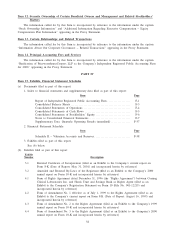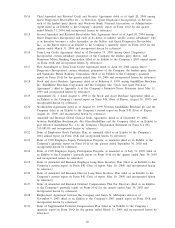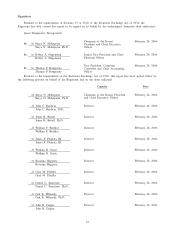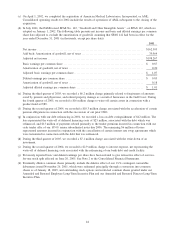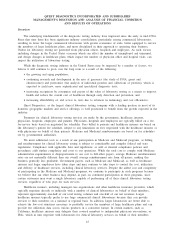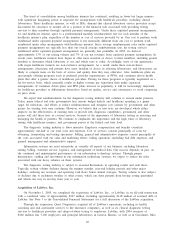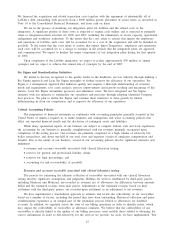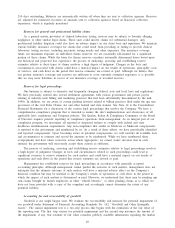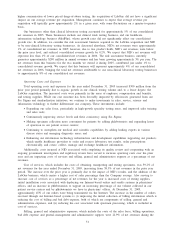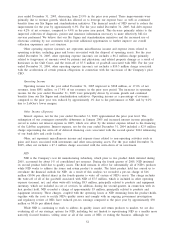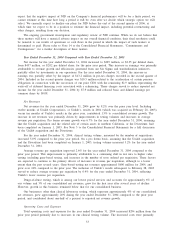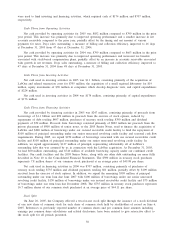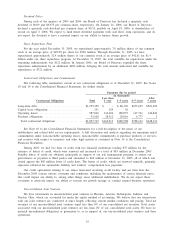Quest Diagnostics 2005 Annual Report Download - page 64
Download and view the complete annual report
Please find page 64 of the 2005 Quest Diagnostics annual report below. You can navigate through the pages in the report by either clicking on the pages listed below, or by using the keyword search tool below to find specific information within the annual report.We financed the acquisition and related transaction costs together with the repayment of substantially all of
LabOne’s debt outstanding with proceeds from a $900 million private placement of senior notes, as described in
Note 10 to the Consolidated Financial Statements, and from cash on hand.
We are in the process of finalizing our integration plans for LabOne and the related costs of the
integration. A significant portion of these costs is expected to require cash outlays and is expected to primarily
relate to integration-related activities for 2006 and 2007, including the elimination of excess capacity, operational
realignment and workforce reductions. To the extent that the costs relate to actions that impact the employees
and operations of LabOne, such costs will be accounted for as a cost of the acquisition and will be included in
goodwill. To the extent that the costs relate to actions that impact Quest Diagnostics’ employees and operations,
such costs will be accounted for as a charge to earnings in the periods that the integration plans are approved
and communicated. We expect to finalize the major components of our integration plans during the first quarter
of 2006.
Upon completion of the LabOne integration, we expect to realize approximately $30 million of annual
synergies and we expect to achieve this annual rate of synergies by the end of 2007.
Six Sigma and Standardization Initiatives
We intend to become recognized as the quality leader in the healthcare services industry through utilizing a
Six Sigma approach and Lean Six Sigma principles to further increase the efficiency of our operations. Six
Sigma is a management approach that enhances quality and requires a thorough understanding of customer
needs and requirements, root cause analysis, process improvements and rigorous tracking and measuring of key
metrics. Lean Six Sigma streamlines processes and eliminates waste. We have integrated our Six Sigma
initiative with our initiative to standardize our operations and processes through adopting identified Company
best practices. We plan to utilize Six Sigma and continue these initiatives to drive growth by further
differentiating us from our competition, and to improve the efficiency of our operations.
Critical Accounting Policies
The preparation of financial statements in conformity with accounting principles generally accepted in the
United States of America requires us to make estimates and assumptions and select accounting policies that
affect our reported financial results and the disclosure of contingent assets and liabilities.
While many operational aspects of our business are subject to complex federal, state and local regulations,
the accounting for our business is generally straightforward with net revenues primarily recognized upon
completion of the testing process. Our revenues are primarily comprised of a high volume of relatively low
dollar transactions, and about one-half of our total costs and expenses consist of employee compensation and
benefits. Due to the nature of our business, several of our accounting policies involve significant estimates and
judgments:
•revenues and accounts receivable associated with clinical laboratory testing;
•reserves for general and professional liability claims;
•reserves for legal proceedings; and
•accounting for and recoverability of goodwill.
Revenues and accounts receivable associated with clinical laboratory testing
The process for estimating the ultimate collection of receivables associated with our clinical laboratory
testing involves significant assumptions and judgments. Billings for services reimbursed by third-party payers,
including Medicare and Medicaid, are recorded as revenues net of allowances for differences between amounts
billed and the estimated receipts from such payers. Adjustments to the estimated receipts, based on final
settlement with the third-party payers, are recorded upon settlement as an adjustment to net revenues.
We have implemented a standardized approach to estimate and review the collectibility of our receivables
based on a number of factors, including the period they have been outstanding. Historical collection and payer
reimbursement experience is an integral part of the estimation process related to allowances for doubtful
accounts. In addition, we regularly assess the state of our billing operations in order to identify issues, which
may impact the collectibility of receivables or allowance estimates. We believe that the collectibility of our
receivables is directly linked to the quality of our billing processes, most notably those related to obtaining the
correct information in order to bill effectively for the services we provide. As such, we have implemented “best
47



